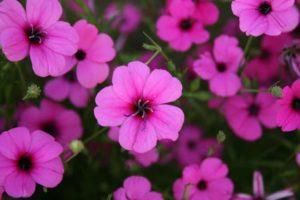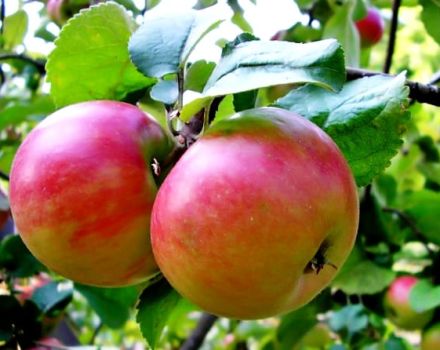Why calla lilies do not bloom in the open field and what to do, how to make them bloom
Growing callas at home involves following certain recommendations regarding planting and further care. This popular ornamental plant for active growing needs a sufficient amount of light, heat and a well-chosen capacity. But there are situations when the expected flowering phase is not observed, which greatly upsets the owner. To understand why calla lilies do not bloom, you need to consider in more detail the main reasons for such negative consequences and methods for eliminating them.
Why calla lilies don't bloom
There are several main reasons that calla lilies lack flowers. In total, they are the same, both for growing an African guest in an open area, and at home.
In the open field
Garden calla lilies do not respond well to planting them in the shade. It is better to choose a landing site in a slightly darkened place, where the sun's rays appear in the first half of the day. It is also dangerous to spot calla lilies in a clearing in the open sun, there is a high probability of burns on the leaf plates. For calla lilies to bloom, the light must be diffused.
Planting on a hill can also cause calla lilies to not bloom; it is recommended to choose a site in the lowlands. Even the close location of groundwater is not afraid of them. Thickened or shallow plantings often lead to such negative consequences. The distance between the calla lilies should be 30-40 centimeters, and the planting depth should be 10-20 centimeters.
Calla lilies often do not have flowers when planted in soil with high acidity, the soil must be neutral. To achieve flowering from calla lilies in the garden, do not overdo it with the introduction of nitrogen-containing preparations.

At home
When kept at home, calla lilies bloom only twice a year (in May and October). If flowering does not occur, then it is worth revising the growing conditions. Common reasons include:
- frequent movement of the flowerpot from one place to another;
- overgrown tubers;
- transplant abuse;
- lack of lighting;
- nutritional deficiencies;
- mistakes when leaving during the active growing season.
It is better to add fertilizer mixtures to the soil in January-March, with a frequency of 1 time in 7 days.
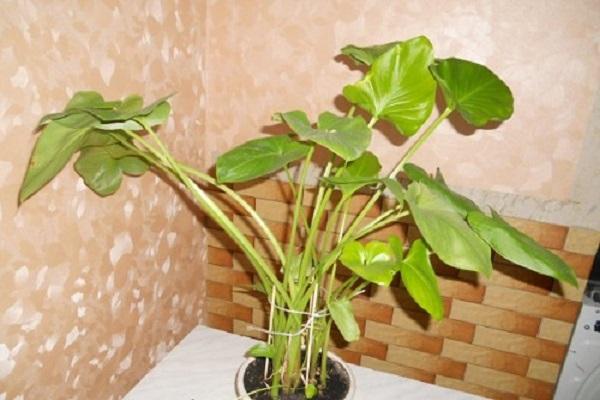
Factors provoking the lack of flowering
In order for calla lilies to bloom regularly, you need to know what factors adversely affect the plant:
- disturbances in care when the decorative culture is at rest;
- not dividing the root, the procedure should be performed once every 2-3 years;
- unsuitable flower container, it can be either small or very large;
- surface embedding of tubers in the ground;
- an excess of nutrients in the soil in the soil substrate;
- lack of moisture;
- care errors.
Ways to make a plant bloom
Often novice plant growers do not know what to do to make calla lilies bloom. But there are several effective ways to achieve the formation and blooming of buds.
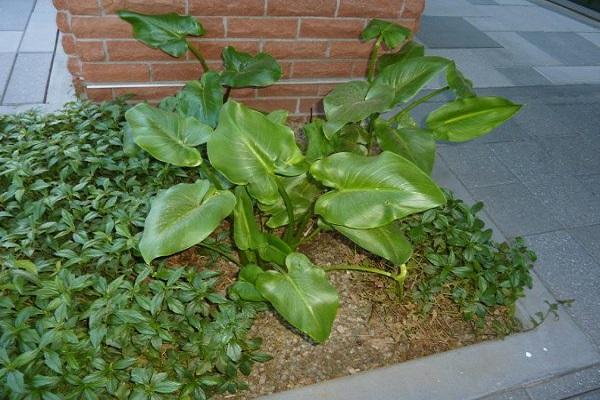
We provide proper watering
Callas are moisture-loving plants and need regular watering. The optimal frequency of irrigation activities is every day or every other day, the main thing is that the water is constantly in the sump. Especially water procedures are useful for feces at the stage of budding. Effectively arrange a shower flower or expose it in the summer rain.
The recommended humidity level for rhizome calla lilies is 70-80%, and for tuberous callas in the range of 50-60%.
Calla lilies should be moistened as soon as the soil dries out to a depth of 1 centimeter. The main thing is that the complete drying out of the soil mixture in the pot must not be allowed, otherwise the flowering phase will be postponed for six months. It is desirable to use a settled and soft liquid for irrigation, cold water is the reason for the lack of flowering in callas. When the budding stage is over, the white varieties of calla lilies are watered as little as possible, and the colored ones only begin to moisturize after 1-2 months.
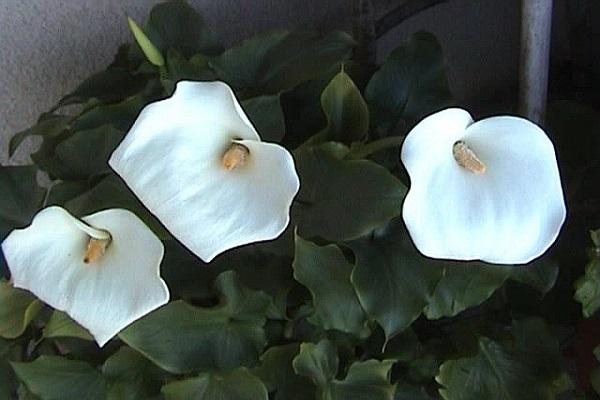
Transplanting calla lilies into a spacious pot
Under natural conditions, the African plant is actively growing and developing, but at home it is under real stress. After acquisition, it is transplanted into a wider and deeper container. Also, the pot should be replaced as the root system grows, otherwise various ailments will begin to progress in a cramped flowerpot.
A pot for growing calla lilies must meet the following parameters:
- the height of the container should be 2 times the size (length) of the root mass;
- the width of the pot should be 5 centimeters larger than the crown.
You should also control the appearance of children in a pot, which displace an adult bush and deprive it of the opportunity to bloom. In order to avoid such consequences, it is recommended to plant the children in time or to transplant them together with the mother plant into a more suitable vessel.
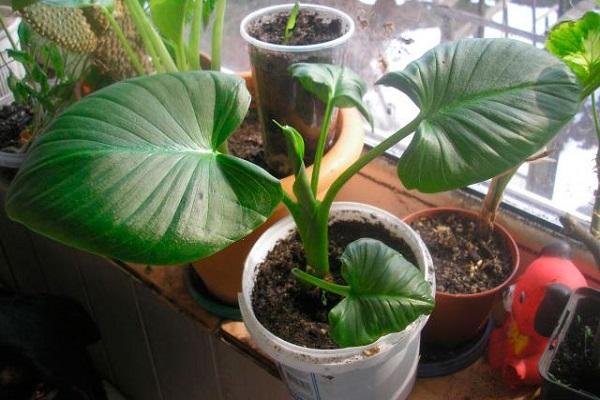
Provide peace
It is so laid down by nature that kalam need regular rest. They cannot please with their luxurious flowering all year round; also, the ability of plants to provide all vegetative organs with a sufficient amount of useful components is reduced. If the dying off of leaf plates and strengthening of the root system is observed during the dormant period, then you should not be afraid, this is a completely natural process.
How much calla lilies should rest
For the dormant period, which ends 3 months after the blooming of the buds, the plant must be located in a cool place and the amount of watering must be reduced. When the flowers wake up, they are transferred back to a light window sill and regular irrigation activities and feeding procedures are resumed. Evidence of a successful exit from the rest period is the growth of a lush green leaf mass by the plant and the appearance of buds.
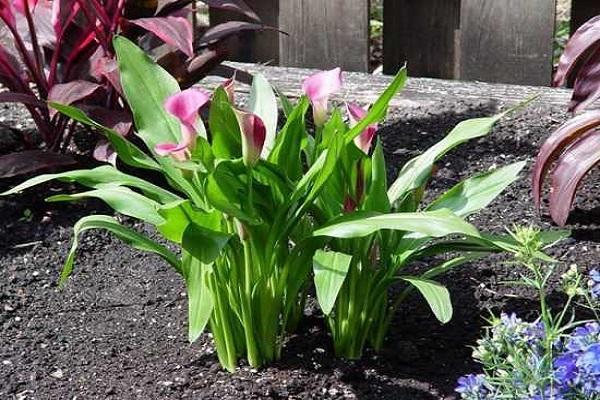
We regularly apply top dressing
For a full-fledged flowering process, the plant needs sufficient nutrients, otherwise it does not have enough strength to form buds. A weak root system cannot fully saturate the aerial part with useful components, which is why there are no flowers.To provide a green pet with good support and stimulate the flowering process, it is necessary to regularly use phosphorus-potassium fertilizer to enrich the soil.
Tips and tricks from gardeners
If there is a desire to acquire such a luxurious and abundantly flowering plant like calla lilies, then you must adhere to the following recommendations:
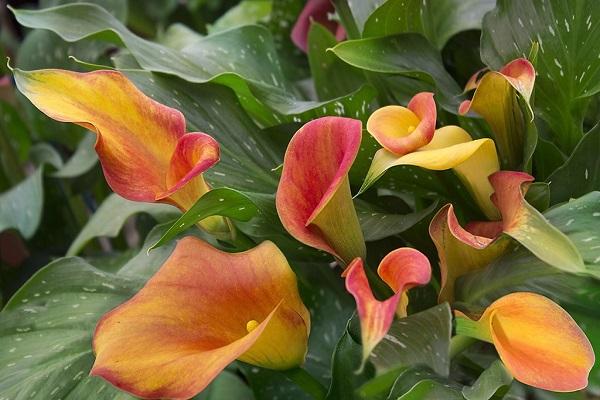
- You need to determine the flower pot on the windowsill, where the sun shines in the morning.
- The transplant container should be spacious, at least 60 centimeters high. The radius from the point of growth of the calla lily should be at least 20 centimeters.
- You should not ignore the feeding procedures, the flower responds to them with gratitude. Not only ready-made nutritional compositions are suitable for these purposes, but also folk methods. Around the ornamental plantation, you need to form a groove and put in it fragments of peel from fruits, husks from seeds. They should be sprinkled with soil mixture.
- Irrigation activities must be carried out exclusively with filtered water or separated room temperature. Watering and brewing is useful.
- To avoid trouble when growing an African guest, it is necessary to remove the topsoil and replace it with a new, fertile one. The main thing is to do everything with caution, otherwise there is a high probability of injury to the root system. This technique allows you to further reduce the frequency of transfer operations.
- White calla lilies require more moisture than colored ones, bright light is more important for them, and should not be thrown away if they shed their leaves during the rest period.
Calla lilies, for a reason, occupy one of the leading positions among ornamental crops used in home floriculture. This unpretentious plant grows and develops quite normally in indoor conditions, the main thing is to observe a certain temperature regime and humidity level.

